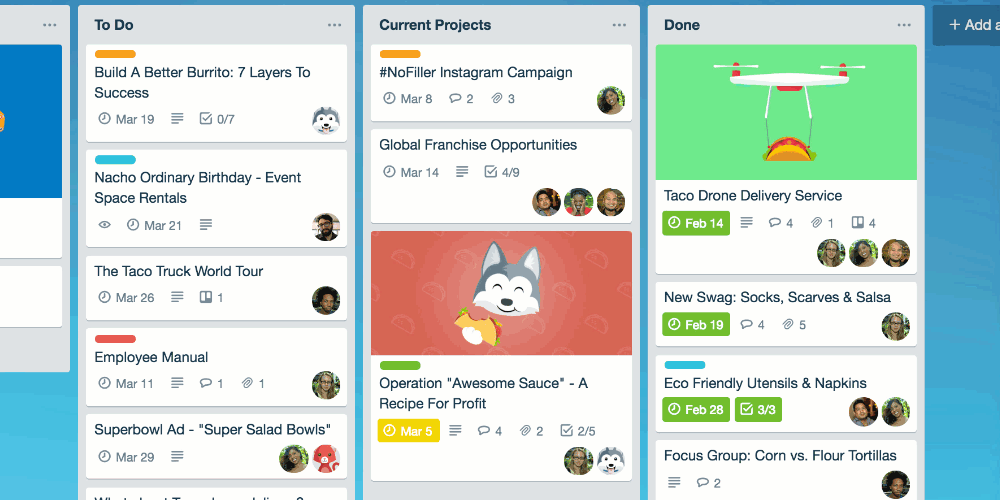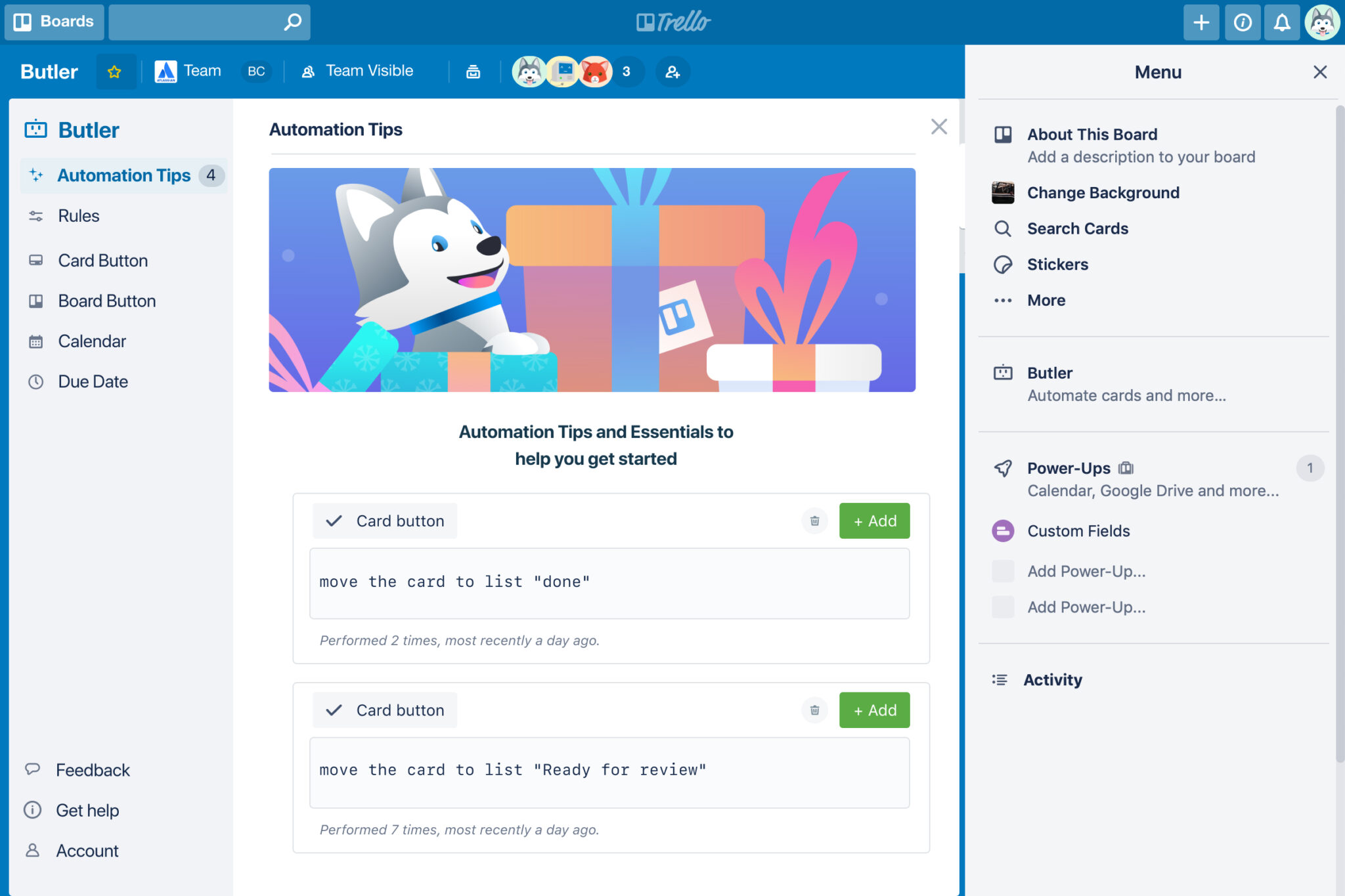Say goodbye to the tedious clicks and endless card drags of yesteryear, and say hello to custom automations, rules, scheduled commands, and so much more! Consider Butler to be the robo-sidekick for your team’s productivity, allowing you to create a seamless process for any task or workflow at the board or card level.
Plus, Butler doesn’t require some fancy degree in coding. Automations are easily created using natural language, so it’s like productivity Mad Libs. Simply go through Automation’s command building window and select what you would like Butler to do, and it will do it all for you without your having to write a line of code. No code, FTW!
Best of all, Butler is available to all Trello users—to learn more about the Butler features that come with your Trello account, check out this handy help document.
To add Butler’s powerful automations to your boards simply click the Butler icon in the board menu and begin giving your board butler things to do. Since there are infinite ways to use Butler’s superpowers, we’ve provided a few examples.
Play By The Rules (Trust Us!)
Imagine this: You’ve finished your latest project, you wipe the sweat off your brow, you drag a card to Done, and *instantly* the remaining checklist items are marked complete, the due date is marked complete, and you are removed from the card—all without you having to do a thing.

Rules will automatically react to actions on your boards like magic and operate across the entire board for all members. Plus, they can be built to handle a lot of complex actions and bring an automated process to your boards.
For instance, if you are on a Sales team and have a contract that needs review by Legal, you can set up a rule so that whenever a card is moved into the “Legal Review” list, your legal review process checklist is added to the card with a due date for 2 days from then, and have it assigned to your team’s lawyer.

Setting up a rule is as simple as filling in the fields for what you’d like to happen when a specific action or trigger takes place. For instance, in my initial example a trigger would be set for when a card is moved into the “Done” list by anyone on the board. Then establish the actions that would automatically occur when that action is triggered:
- Mark the due date as complete
- Check all the items in all the checklists on the card
- Remove all the members from the card.
Triggers can be set for a variety of actions including:
- When cards are added, moved, or archived
- Labels, members, and votes are added to cards
- Due dates are added, marked complete, or included in card names
- Actions are taken on checklists or checklists are added to cards
- Comments and card description updates
- When Custom Field data is entered, updated, set, etc.
When a trigger is activated some of the possible actions could be:
- Moving, archiving, or copying cards
- Adding or removing labels, members, and more
- Setting, changing, or updating due dates
- Adding, completing, or resetting checklists
- Joining, subscribing, and adding/removing members from cards
- Renaming cards, editing descriptions, adding comments
- Modifying, adding, or removing Custom Field data
- Sorting lists by a variety of criteria
- Interacting with related cards
- Sending emails
- Gets, posts, and puts to URLs
- And so much more!
Honestly, it is amazing to simply dig around and see what Butler can do to tackle almost any request you send its way.
Example Use Cases For Rules
- Get an overview of your team’s work getting done across all of your boards in a single place. For example, set a rule on each of your team boards to make a copy of every card that is moved to a board’s Done list to the team overview board.
- When a card is created in a “To Do” list, add the “Steps” checklist so that you don’t miss a beat.
- When someone is added to a card, have Butler automagically set the due date to five working days in the future and post comments like, “I got this.” What a team player!
- When you enter a card name ending with a date, set the card to be due on that date. Perfect for when emailing cards to your board.
- When the checklist “Phase 1 Steps” is completed by anyone, move the card to list “Phase 2” and add checklist “Phase 2 Steps.” As they say, process makes perfect.
Building Buttons For A Better Way To Work
Butler also allows you to create custom automations for cards and boards that are executed at the click of a button. Card buttons handle card level tasks, and appear on the card back. Board buttons, on the other hand, appear at the top of your board and accomplish tasks across your entire board.

What’s really exciting is that you can create buttons that can perform multiple operations in a single click.
For instance, a card button, when clicked, could move that card to a specific list, add a due date for two days in the future, add a board member, and apply a specified label. Or, a board button could move every card with an overdue due date to a specified list and sort them by label.
Plus, Butler is a team player which means that card and board buttons created by anyone on the board can be used by everyone. This keeps your entire team on the same page when creating a process around actions, whether it’s to notify the next person in a workflow, or prioritize tasks for the week.

To create custom buttons, start by selecting whether you want to create a card button or a board button and name the button. Then, creating a task is as simple as going through and adding the actions you want to occur and filling in the details, like which list or label.

Card button actions can include any or all of the following:
- Moving or archiving a card
- Adding/removing labels and due dates
- Marking due dates complete
- Checking/unchecking checklist items, adding checklists to cards, and resetting checklists
- Joining, subscribing, and adding/removing members from cards
- Adding comments, renaming cards, and modifying card descriptions
Board button actions can include:
- Creating new cards with descriptions in specified lists
- Creating, archiving, and arranging lists
- Moving and archiving cards in a list
- Sorting cards in a list by date, name, votes, custom fields, labels, and time on list
Example Use Cases For Buttons

- Ready to get to work? Create a card button to start a task that moves the card to list “In Progress,” and adds you to the card with a due date.
- Start each week fresh with a board button to archive the past week’s “Done” list and create a new “Done” list.
- Add a card button that automatically moves the card to “Done,” marks the due date as complete, and removes you from the card. You can even set up Butler to automatically add a comment that lets your boss know how awesome you are.
- Never know what to work on next? Add a board button to move a randomly-selected card from the “To Do” list to the “Doing” list. Don’t let analysis paralysis curb your productivity.
- Let’s say you apply a green label to every bug you fix, so your team knows what’s already shipped. Create a board button to auto-archive all of those cards with a green label and save a lot of precious clicks.
- Get insight into your infinite backlog by creating a button to sort cards by Custom Field story points, due date, votes, and more so you know what to prioritize next sprint.
Make Time Work For You
You also have the ability to setup Butler to work on whatever schedule works for you with scheduled commands based on calendar dates or a card’s due date.
Calendar commands are great for recurring tasks and regular board maintenance like moving and archiving cards, sorting lists, and adding new lists to a board. These commands can be set to run at specific times on daily, weekly, monthly, and yearly times of your choosing.

For instance, on a weekly sprint board you could set a calendar command to make the start of each week as smooth as possible:
- Every Monday at 9 AM,
- Archive all of the cards in the Last Week list
- Move the cards from the This Week list to the Last Week list
- Move all of the cards from Up Next to This week and sort them by due date.
If only Butler could also make sure there was a fresh pot of coffee ready for you as well when you stepped into the office. ☕️
Due date commands use a card’s due date as a trigger and can be programmed to take a series of actions as a card’s due date gets closer, the moment is due, or a set period of time after the card is due.

Setting due date commands is a great way to make sure nothing important falls through the cracks by flagging incomplete cards that are overdue:
- The moment a card is due
- Move the card to the top of the list
- Add the red label to the card
- Post a comment “@card What’s the status of this?”
Scheduled commands offer a powerful way to keep your boards and cards organized and maintained so that you can spend more time focussing on the finer things in life, like that blog post you were supposed to write last week that Butler totally just reminded you about.
Butler Brings The White Glove Service

If that’s not enough, what makes Butler truly a cut above the rest is that as soon as Butler is enabled on your boards it immediately has ideas to make your life easier. When you open the Butler, click the “Automation Tips” button and Butler will automatically take a quick scan of your board to analyze the most common actions, and suggest them as recommended buttons that can be created in a click. Talk about being prepared for your first day on the job.
So go ahead and bring the power of automation with Butler to your boards today!
Want to get an in-depth overview of everything Butler has to offer? Watch our free on-demand webinar:
Bring Powerful Automation To Your Boards With Butler
Read this in French, German, Portuguese, or Spanish.
Good or bad, we’d love to hear your thoughts. Find us on Twitter (@trello)
